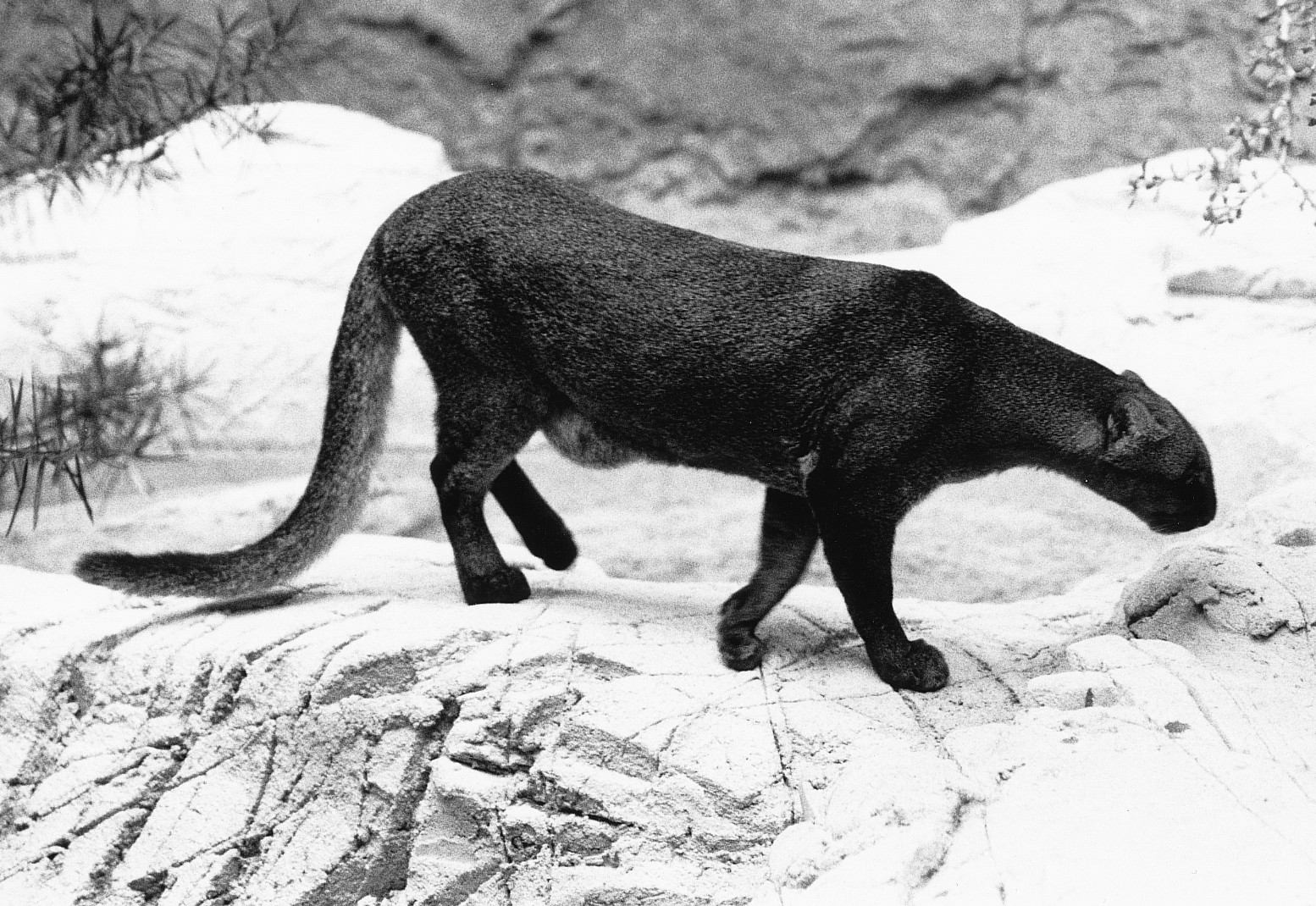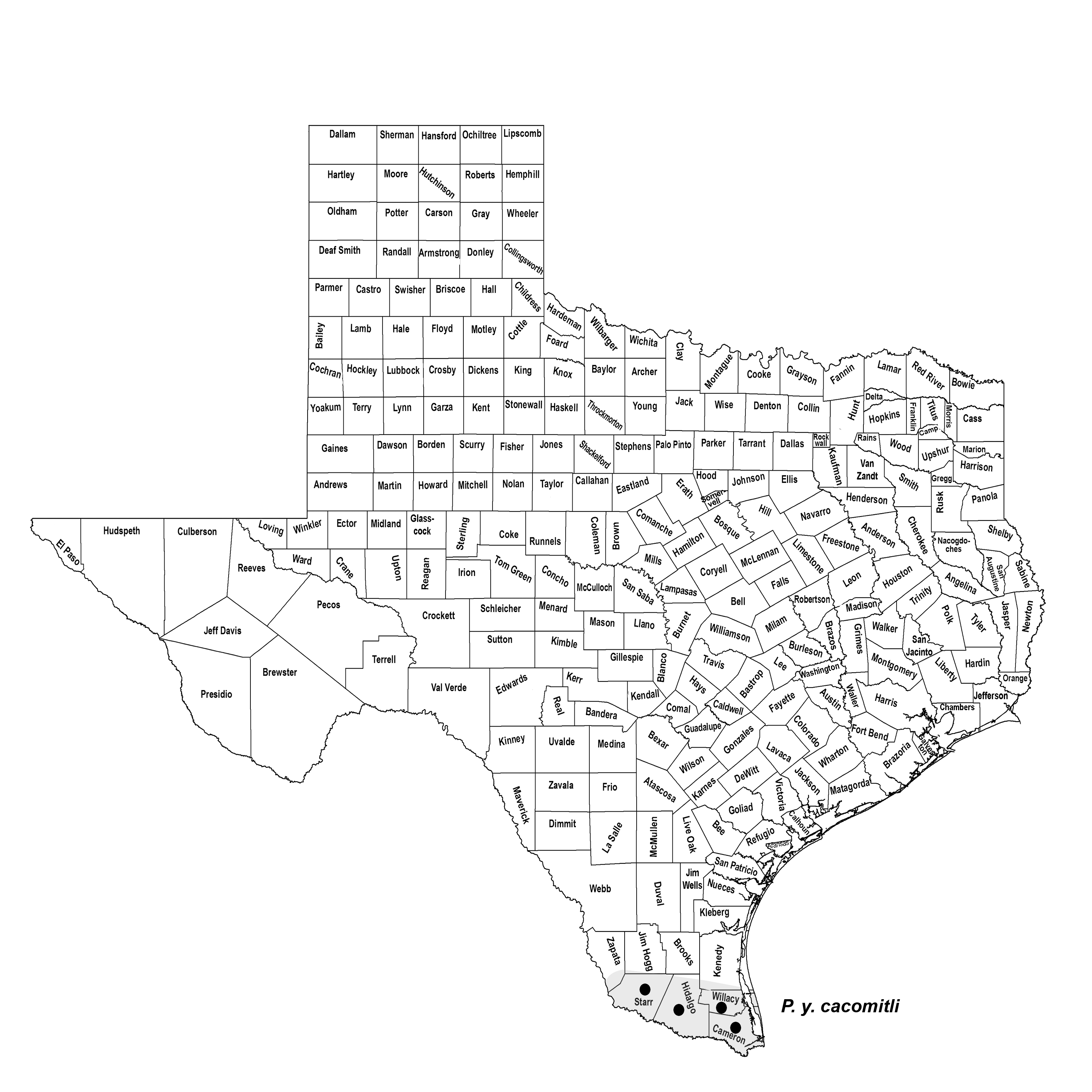JAGUARUNDI
Puma yagouaroundi (Lacepede 1809)
Order Carnivora : Family Felidae
DESCRIPTION. Small, slender-bodied, long-tailed, unspotted, weasel-like cat; size somewhat larger than the ordinary alley cat; legs short for a cat; two color phases. Grayish phase: upperparts grizzled, salt-and-pepper gray; underparts slightly paler; more black in winter pelage. Red phase: upperparts reddish, intermixed with blackish; head and legs more brownish; lips and throat usually whitish. Dental formula: I 3/3, C 1/1, Pm 3/2, M 1/1 × 2 = 30. External measurements of an adult male: total length, 1.1 m; tail, 572 mm; hind foot, 137 mm; females usually smaller. Weight, 4–8 kg.

DISTRIBUTION. Formerly occurred in the brush country of extreme southern Texas in Cameron, Hidalgo, Starr, and Willacy counties. Never documented north of the Rio Grande Valley in recorded history, currently extinct in Texas.

SUBSPECIES. Puma y. cacomitli.
HABITS. Jaguarundis occur in the dense, thorny thickets of southern Texas where cacti, mesquite, catclaw acacia, granjeno, and other spine-studded vegetation exist. They spend most of their time on the ground, but they are expert climbers and garner part of their food in the trees and bushes. They are largely active at night but move about a good deal in the daytime, often going to water to drink at midday.
Their food consists of rats, mice, birds, and rabbits. They also depredate poultry. Robert Snow stated that their primary food is birds and that the young in the dens are fed a similar diet. He reported seeing one old cat spring about 1.5 m into the air and knock feathers out of a low-flying dove. An analysis of stomach contents from 13 Venezuelan jaguarundis revealed the remains of lizards, rodents, small birds, cottontail rabbits, and grass.
Their breeding habits are not well known. F. B. Armstrong, a naturalist of Brownsville, Texas, was of the opinion that they have no regular breeding season. He found young in both summer and winter, born probably in March and August. Snow found their dens under fallen trees grown over with grass and shrubs and in thickets. The dens were exceptionally well concealed, and he described them as merely "forms" in this protective cover. He found young in the den only in March, the number always being three kittens. The kittens of a litter all may be slate blue, all chocolate brown, or some of them may be blue and the others reddish brown. He reported finding several litters in the vicinity of Raymondville, Willacy County.
Studies by Michael Tewes and colleagues (Texas A&M–Kingsville) found jaguarundis used the same dense brush habitats occupied by ocelots in northern Mexico. Sometimes jaguarundis used bunchgrass pastures but usually escaped to nearby woody thickets when disturbed.
POPULATION STATUS. Extinct. Jaguarundis are now likely extinct in Texas. The last documented record of a jaguarundi in the United States was in 1986 when a road-killed individual was salvaged 3.2 km (2 mi.) south of Brownsville, Texas.
Occasionally, we receive reports of a Texas sighting, but no professional biologist has encountered one and no specimens are available since the 1970s. In addition, although many people have reported jaguarundis in central Texas (and other states), these felines have never been observed north of extreme South Texas. As with the jaguar and ocelot, predator control and habitat destruction took their toll on this species.
CONSERVATION STATUS. The IUCN lists the jaguarundis' status as least concern and decreasing in numbers. It is listed as endangered by TPWD and USFWS. The clearing of brushlands in the Rio Grande Valley for agriculture and urban land uses have led to the demise of the jaguarundis, and only habitat restoration and reintroductions can return this species to Texas. Private landowners can play a vital role in returning this species to Texas.
REMARKS. The genus name for this species has been changed from Herpailurus to Puma.
Michael Tewes has spent three decades studying ocelots and bobcats in South Texas, and he has been vigilant in attempting to document jaguarundis. He has not found any specimens or verifiable sightings and is convinced the species is now gone from Texas.
From The Mammals of Texas, Seventh Edition by David J. Schmidly and Robert D. Bradley, copyright © 1994, 2004, 2016. Courtesy of the University of Texas Press.
Natural Science Research Laboratory
-
Address
Museum of Texas Tech University, 3301 4th street, Lubbock, TX 79409 -
Phone
806.742.2486 -
Email
nsrl.museum@ttu.edu

